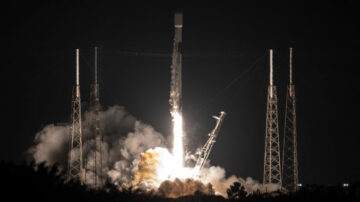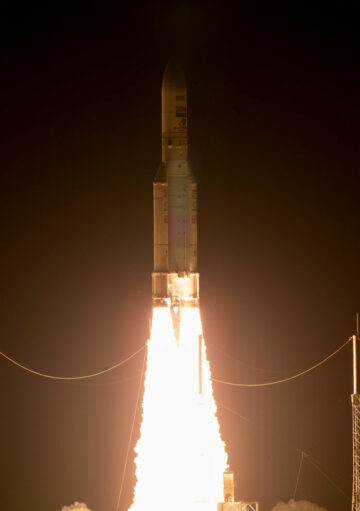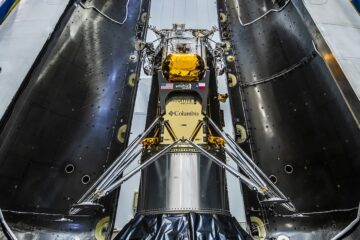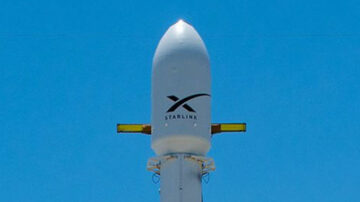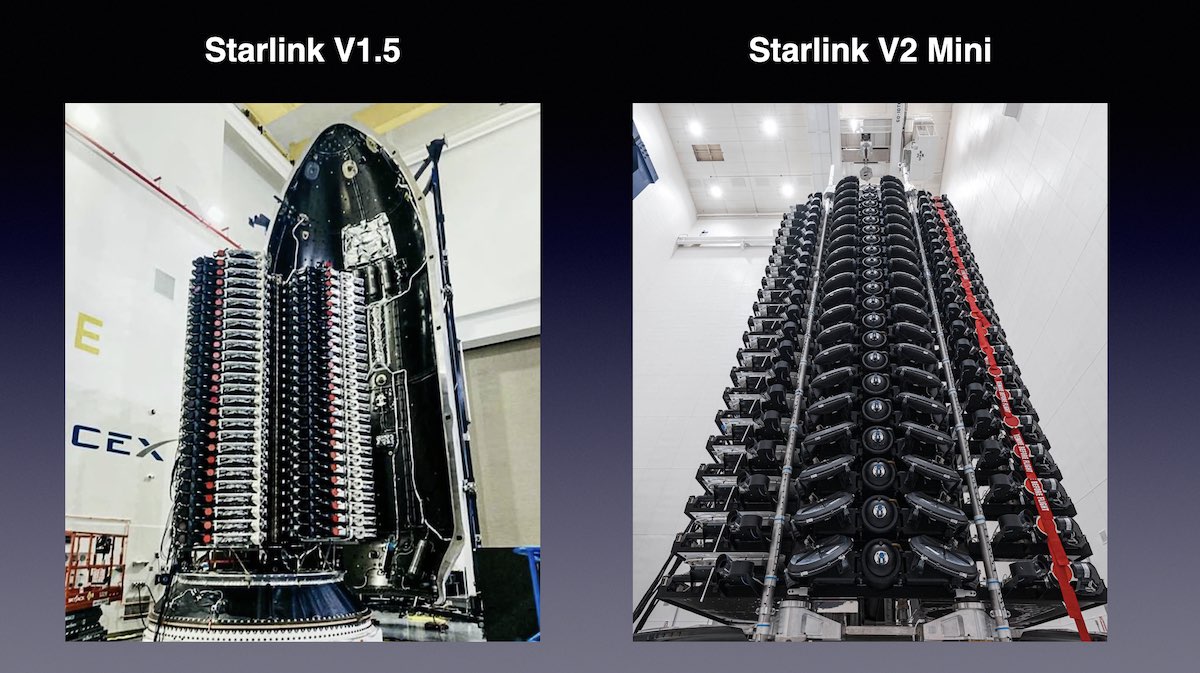
SpaceX’s next two missions will revert to launching older versions of the company’s Starlink internet satellites, instead of new second-generation Starlink platforms as originally planned, while ground teams work out unspecified problems with the first batch of upgraded Starlinks launched in February.
The next two SpaceX launches with Falcon 9 rockets will each carry more than 50 Starlink internet satellites into orbit, beginning with the scheduled liftoff of a Falcon 9 from Cape Canaveral Space Force Station at 11:33 a.m. EDT (1533 UTC) Friday. Another Falcon 9 launch from Cape Canaveral is tentatively scheduled for next Wednesday, March 29, at approximately 9:27 a.m. EDT (1327 UTC).
Both launches were originally slated to loft more batches of SpaceX’s upgraded Starlink satellites. The second-generation “Starlink V2 Mini” satellites are fitted with improved phased array antennas and have four times the communications capacity of earlier generations of Starlink satellites, known as Version 1.5, SpaceX said.
The first group of 21 upgraded Starlink V2 Mini satellites launched Feb. 27 on a Falcon 9 rocket, which released the spacecraft into orbit at an altitude of about 230 miles (370 kilometers). Publicly-available orbital data showed the satellites raised their altitude to nearly 240 miles (about 380 kilometers), but the spacecraft began gradually descending in mid-March.
Starlink satellites typically active their thrusters to begin maneuvering from their initial orbit, where they are deployed by the Falcon 9 rocket, to higher operating altitudes more than 300 miles above Earth. The stall in orbit-raising raised questions among some observers about the status of the new Starlink V2 Mini satellites.
“Lot of new technology in Starlink V2, so we’re experiencing some issues, as expected,” Musk tweeted Wednesday. He added that some of the Starlink V2 Minis satellites could be deorbited, while others will be “tested thoroughly” before boosting above the altitude of the International Space Station, which flies at 260 miles (420 kilometers) altitude.
The Falcon 9 launches Friday and March 29 were originally supposed to carry upgraded Starlink V2 Mini satellites, but SpaceX has swapped out those stacks of second-generation satellites for groupings of older Starlink V1.5 spacecraft. SpaceX has not confirmed if the problems with the first 21 Starlink V2 mini satellites were the reason for the payload swaps on the next two Falcon 9 missions.
Friday’s launch is designated Starlink 5-5 in SpaceX’s launch sequence, and the mission set for March 29 is named Starlink 5-10. The launches will deliver batches of older-design satellites into orbits that are part of the Starlink second-generation, or Gen2, constellation, which will ultimately be primarily populated by Starlink V2 Mini satellites and a larger spacecraft platform called Starlink V2 sized to launch on SpaceX’s enormous future Super Heavy booster and Starship rocket.
The Starship has nearly 10 times the payload lift capability of a Falcon 9 rocket, with greater volume for satellites, too.

The Starlink V2 satellites will be capable of transmitting signals directly to cell phones, a step forward in connectivity from space that other companies are also pursuing. The V2 Mini satellites introduce E-band for backhaul links with gateway stations.
“This means Starlink can provide more bandwidth with increased reliability and connect millions of more people around the world with high-speed internet,” SpaceX said before the first launch of Starlink V2 Mini satellites last month.
Another change on the upgraded Starlink V2 Mini satellite design is in the propulsion system. The new satellites are propelled by an argon-fueled electric thruster system, capable of producing 2.4 times the thrust with 1.5 times the specific impulse, or fuel efficiency, of the krypton-fueled ion thrusters on the first generation of Starlink satellites.
Each Starlink V2 Mini satellite weighs about 1,760 pounds (800 kilograms) at launch, nearly three times heavier than the older Starlink satellites. The are also bigger in size, with a spacecraft body more than 13 feet (4.1 meters) wide, filling more of the Falcon 9 rocket’s payload fairing during launch, according to regulatory filings with the Federal Communications Commission.
The larger, heavier satellite platform means a Falcon 9 rocket can only launch about 21 Starlink V2 Mini payloads at a time, compared to more than 50 Starlink V1.5s on a single Falcon 9 launch.
The two deployable solar panels on each Starlink V2 Mini satellite span about 100 feet (30 meters) tip-to-tip. The previous generation of Starlink V1.5 satellites each have a single solar array wing, with each spacecraft measuring about 36 feet (11 meters) end-to-end once the solar panel is extended.
The enhancements give the Starlink V2 Mini satellites a total surface area of 1,248 square feet, or 116 square meters, more than four times that of a Starlink V1.5 satellite.
The FCC granted SpaceX approval Dec. 1 to launch up to 7,500 of its planned 29,988-spacecraft Starlink Gen2 constellation, which will spread out into slightly different orbits than the original Starlink fleet. The regulatory agency deferred a decision on the remaining satellites SpaceX proposed for Gen2.
SpaceX began launching older-generation Starlink V1.5 satellites into the Gen2 constellation on Dec. 28.
The FCC previously authorized SpaceX to launch and operate up to 12,000 Starlink satellites, including roughly 4,400 first-generation Ka-band and Ku-band Starlink spacecraft that SpaceX has been launching since 2019.
The Gen2 satellites could improve Starlink coverage over lower latitude regions, and help alleviate pressure on the network from growing consumer uptake. SpaceX says the network has more than 1 million active subscribers, mostly households in areas where conventional fiber connectivity is unavailable, unreliable, or expensive.
The Starlink spacecraft beam broadband internet signals to consumers around the world, connectivity that is now available on all seven continents.
According to Jonathan McDowell, an astrophysicist and expert tracker of spaceflight activity, SpaceX has launched more than 4,100 Starlink satellites to date, and more than 3,800 of the spacecraft are currently in orbit. The rest were prototypes, failed spacecraft, or satellites intentionally commanded to re-enter the atmosphere and burn up.
Jonathan Hofeller, SpaceX’s vice president of Starlink commercial sales, said earlier this month the company is producing about six satellites per day at a Starlink factory near Seattle.
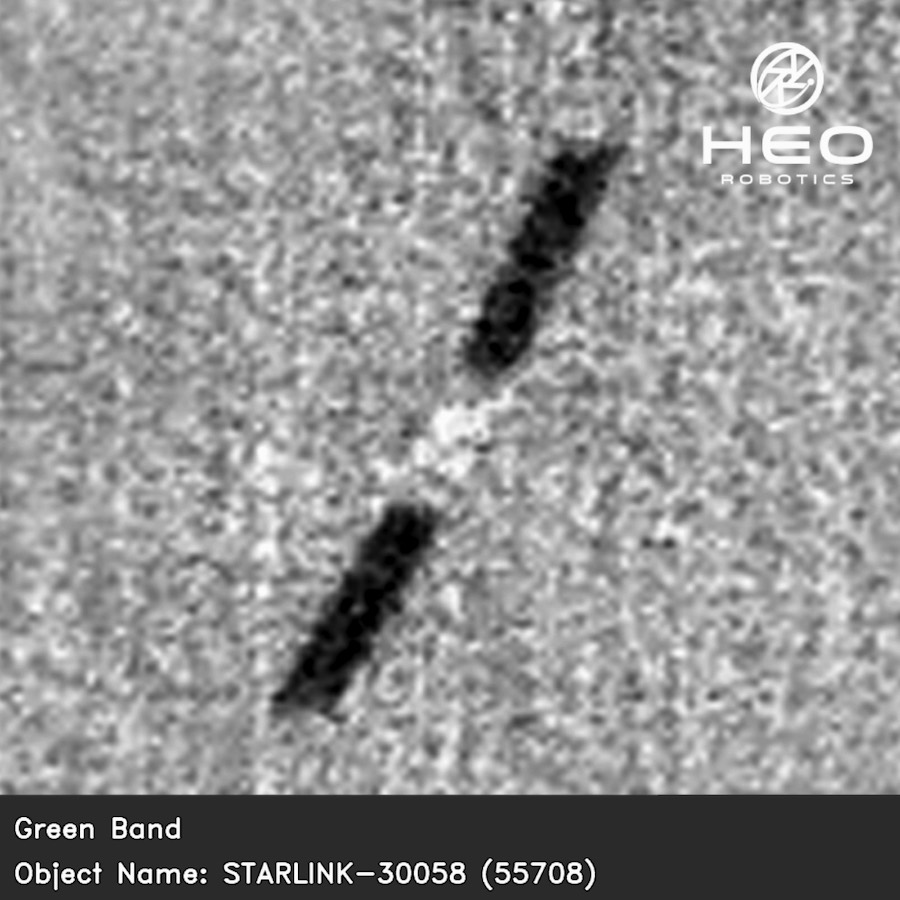
SpaceX test-fired the Falcon 9 rocket that will launch the next 56 Starlink satellites at 9 a.m. EDT (1300 UTC) Thursday on pad 40 at Cape Canaveral. After a data review, engineers were expected to give the go-ahead for final launch preparations Friday morning. SpaceX has three launch opportunities for the Starlink 5-5 mission at 11:33 a.m., 1:14 p.m., and 2:55 p.m. EDT Friday.
Forecasters from the U.S. Space Force’s 45th Weather Squadron predict a greater than 95% chance of favorable weather for liftoff Friday.
It will take more than an hour for the Falcon 9 rocket to deploy the 56 Starlink satellites into their targeted orbit, following two burns by the launch vehicle’s upper stage engine. The Falcon 9’s first stage, flying for the 10th time, will aim for landing on a drone ship northeast of the Bahamas around eight-and-a-half minutes after launch.
Email the author.
Follow Stephen Clark on Twitter: @StephenClark1.
- SEO Powered Content & PR Distribution. Get Amplified Today.
- Platoblockchain. Web3 Metaverse Intelligence. Knowledge Amplified. Access Here.
- Source: https://spaceflightnow.com/2023/03/23/spacex-pausing-launches-of-new-generation-starlink-satellites/
- :is
- ][p
- $UP
- 000
- 1
- 10
- 100
- 11
- 116
- 2019
- 28
- 420
- 7
- 9
- 95%
- a
- About
- above
- According
- active
- activity
- added
- After
- agency
- All
- alleviate
- among
- and
- Another
- approval
- approximately
- ARE
- AREA
- areas
- around
- Array
- AS
- At
- Atmosphere
- author
- available
- Bahamas
- Bandwidth
- BE
- Beam
- before
- began
- begin
- Beginning
- bigger
- body
- boosting
- broadband
- burn
- burns
- by
- called
- CAN
- capable
- Capacity
- carry
- cell phones
- Chance
- change
- COM
- commercial
- commission
- Communications
- Companies
- company
- Company’s
- compared
- comparison
- CONFIRMED
- Connect
- Connectivity
- consumer
- Consumers
- conventional
- could
- coverage
- credit
- Currently
- data
- Date
- day
- decision
- deliver
- deploy
- deployed
- Design
- designated
- different
- directly
- drone
- during
- each
- Earlier
- earth
- efficiency
- Electric
- end-to-end
- Engine
- Engineers
- enormous
- expected
- expensive
- experiencing
- expert
- factory
- Failed
- falcon
- Falcon 9
- FCC
- Feb
- February
- Federal
- Federal Communications Commission
- Feet
- final
- First
- First Generation
- FLEET
- flying
- following
- For
- Force
- Forward
- Friday
- from
- Fuel
- fuel efficiency
- future
- gateway
- generation
- generations
- Give
- gradually
- granted
- greater
- Ground
- Group
- Growing
- Have
- heavy
- help
- higher
- households
- http
- HTTPS
- Imaging
- improve
- improved
- in
- Including
- increased
- initial
- instead
- intentionally
- International
- international space station
- Internet
- introduce
- issues
- ITS
- jpg
- known
- landing
- larger
- Last
- latitude
- launch
- launched
- launches
- launching
- links
- March
- max-width
- MCDOWELL
- means
- measuring
- million
- millions
- minutes
- Mission
- missions
- Month
- more
- morning
- Musk
- Named
- Near
- nearly
- network
- New
- next
- of
- on
- operate
- operating
- opportunities
- Orbit
- original
- originally
- Other
- Others
- pad
- panel
- panels
- part
- People
- phones
- planned
- platform
- Platforms
- plato
- Plato Data Intelligence
- PlatoData
- populated
- pounds
- predict
- president
- pressure
- previous
- previously
- primarily
- problems
- proposed
- propulsion
- prototypes
- provide
- Questions
- raised
- reason
- regions
- regulatory
- released
- reliability
- remaining
- REST
- revert
- review
- rocket
- roughly
- s
- Said
- sales
- satellite
- satellites
- says
- scheduled
- Seattle
- Sequence
- set
- seven
- signals
- since
- single
- SIX
- Size
- slightly different
- So
- solar
- solar panel
- solar panels
- some
- Space
- Space Force
- space station
- spacecraft
- spaceflight
- SpaceX
- span
- specific
- spread
- square
- Stacks
- Stage
- starlink
- starship
- station
- Stations
- Status
- Step
- Stephen
- subscribers
- Super
- supposed
- Surface
- Swaps
- system
- Take
- targeted
- teams
- Technology
- that
- The
- The Bahamas
- the world
- their
- three
- time
- times
- to
- too
- Total
- typically
- u.s.
- Ultimately
- upgraded
- UTC
- v1
- version
- Vice President
- View
- volume
- Weather
- Wednesday
- weighs
- which
- while
- wide
- will
- Wing
- with
- Work
- work out
- world
- zephyrnet

